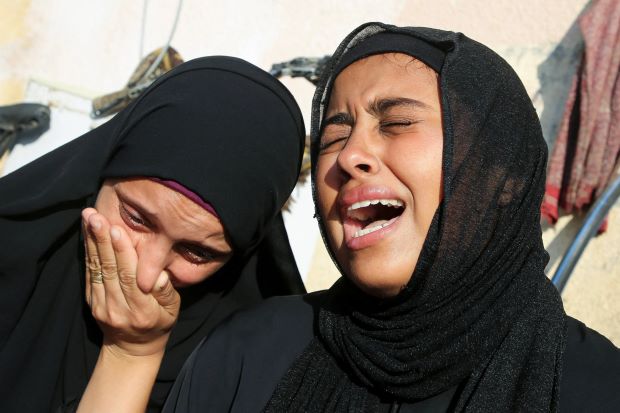Deadly Israeli strike at school-turned-shelter shatters a moment of cheer
By Raja Abdulrahim
JERUSALEM — It was a moment of respite and levity in the Gaza Strip: Boys played soccer in the courtyard of a school building as a crowd looked on.
The moment did not last.
Video shared by Al Jazeera and verified by The New York Times recorded the instant an Israeli airstrike hit outside the school-turned-shelter on Tuesday (9) night, killing at least 27 Palestinians, according to Gaza authorities.
In the video, shot at the Al Awda School on the outskirts of Khan Younis, the ball is in mid-air when a large explosion is heard and the camera shakes. A man yells, “Run away, run away, Al Awda has been targeted!”
The person shooting the video runs to the entrance of the school, and the camera pans across a scene of devastation. Shredded bodies are on the ground amid debris, and there is a cacophony of screams. “Oh God,” someone yells.
The Israeli military said that the strike targeted a Hamas member who took part in the Oct. 7 attacks on Israel that ignited the war. It did not release details on the identity of the Hamas member or whether the person had been killed. The military said it was “looking into reports that civilians were harmed”.
Iyad Qadeh, who was sitting outside his home near the entrance of the school at the time of the strike, said it had been calm and there were not even Israeli surveillance drones in the sky, as there often is above Gaza creating a nearly non-stop buzzing.
Suddenly, a warplane flew overhead and fired a missile toward a group of young men sitting in an internet cafe, he said.
“After that, it was screams and body parts everywhere,” he said. “Everyone started running searching for their children or family members.”
The strike was the fourth in four days that hit or damaged a school building in Gaza, Philippe Lazzarini, commissioner-general of UNRWA, the UN agency that helps Palestinians, wrote on social media Wednesday.
Since Israel began its punishing military offensive in Gaza more than nine months ago, two-thirds of UN-run school facilities in the territory have been hit, Lazzarini wrote. “Schools have gone from safe places of education & hope for children to overcrowded shelters and often ending up a place of death & misery,” he said.
Those shelters have become critical for Palestinians in Gaza since Israeli bombardment and ground fighting have forced much of the territory’s 2.2 million residents to flee their homes. The Israeli military has claimed that militants are using such shelters and other civilian buildings to hide themselves and their activities.
Ghazi Hamad, a senior Hamas official, has said that the group tries to keep Palestinian civilians out of harm’s way.
Most of those injured or killed in the strike Tuesday were taken to Nasser Hospital in Khan Younis in ambulances, private vehicles and donkey carts. Dr Mohammed Saqer, director general of nursing at Nasser, said in a phone interview on Wednesday (10) that 56 people had been wounded, most of them children and women. “And unfortunately nearly 10 cases of amputation among them; hands and feet were completely blown off,” he said.
The state of the bodies brought to Nasser made it difficult to determine the number and identities of the dead, he said.
The influx of traumatic injuries came at a time when the few still-functioning hospitals in the Gaza Strip are struggling to keep running amid Israeli strikes and raids and a lack of medicine, medical equipment and reliable power. “Many of our medical staff have been detained, many have been killed and many have had to leave Gaza,” Saqer said.
There is a shortage, too, of hospital beds, and most of the airstrike victims were treated on the floors of wards or in the hallways, he said.
A video shot by the Reuters news agency at the site of the strike showed the fragment of a weapon. Two weapons experts — Trevor Ball, a former US. Army explosive ordnance disposal technician, and Patrick Senft, a weapons expert at the consulting firm Armament Research Services — identified the fragment as a part of a small-diameter bomb, also known as a GBU-39.
The precision-guided bomb, which is US-made, weighs about 250 pounds and is increasingly the weapon of choice for the Israeli military. Two GBU-39s were used in a deadly strike on a tent camp in Rafah on May 26.
In Gaza, such bombs “are often used to target specific floors in buildings, penetrating through the roof before detonating,” Ball said.
Although smaller in explosive power than the 2,000-pound bombs that have been used elsewhere in Gaza, the bombs “can still cause significant injury and death, especially when used in areas where there is little to no protection for people from blast and fragmentation effects, such as a street, or area with just tents,” Ball said.
-New York Times



Comments are closed, but trackbacks and pingbacks are open.